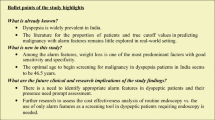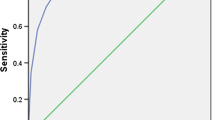Abstract
Background
In August 2004, the United Kingdom Department of Health advisory body published dyspepsia referral guidelines for primary care practitioners. These guidelines advised empiric treatment with antisecretory medications and referral for endoscopy only in the presence of alarm symptoms. The current study aimed to evaluate the effect of these guidelines on the detection of esophagogastric cancer.
Methods
The study reviewed a prospectively compiled database of 4,018 subjects who underwent open access gastroscopy during the years 1990 to 1998. The main outcome measures for the study were cancer detection rates, International Union Against Cancer (UICC) stage, and survival.
Results
Gastroscopy identified esophagogastric carcinoma in 123 (3%) of the 4,018 subjects. Of these 123 patients, 104 (85%) with esophagogastric cancer had “alarm” symptoms (anemia, mass, dysphagia, weight loss, vomiting) and would have satisfied the referral criteria. The remaining 15% would not have been referred for initial endoscopic assessment because their symptoms were those of uncomplicated “benign” dyspepsia. The patients with “alarm” symptoms had a significantly more advanced tumor stage (metastatic disease in 47% vs 11%; p < 0.001), were less likely to undergo surgical resection (50% vs 95%; p < 0.001), and had a poorer survival (median, 11 vs 39 months; p = 0.01) than their counterparts without such symptoms.
Conclusions
The use of alarm symptoms to select dyspeptics for endoscopy identifies patients with advanced and usually incurable esophagogastric cancer. Patients with early curable cancers often have only dyspeptic symptoms, and their diagnosis will be delayed until the symptoms of advanced cancer develop.

Similar content being viewed by others
References
Blackshaw GR, Barry JD, Edwards P, Allison MC, Lewis WG (2003) Open-access gastroscopy is associated with improved outcomes in gastric cancer. Eur J Gastroenterol Hepatol 15: 1333–1337
Bytzer P, Hansen JM, Schaffalitsky de Muckadell OB (1994) Empirical H2-blocker therapy or prompt endoscopy in management of dyspepsia. Lancet 343: 811–816
Ferguson MK, Durkin A (2002) Long-term survival after esophagectomy for Barrett’s adenocarcinoma in endoscopically surveyed and nonsurveyed patients. J Gastrointest Surg 6: 29–35
Fountoulakis A, Zafirellis KD, Dolan K, Dexter SP, Martin IG, Sue-Ling HM (2004) Effect of surveillance on the clinical outcome of esophageal cancer. Br J Surg 91: 997–1003
Fransen GA, Janssen MJ, Muris JW, Laheij RJ, Jansen JB (2004) Meta-analysis: the diagnostic value of alarm symptoms for upper gastrointestinal malignancy. Aliment Pharmacol Ther 20: 1045–1052
Johansson J, Johnsson F, Walther B, Willen R, Stael von Holstein C, Zilling T (1996) Adenocarcinoma in the distal esophagus with and without Barrett esophagus: differences in symptoms and survival rates. Arch Surg 131: 708–713
Maconi G, Kurihara H, Panizzo V, Russo A, Cristaldi M, Marrelli D, Roviello F, de Manzoni G, Di Leo A, Morgagni P, Bechi P, Bianchi Porro G, Taschieri AM, Italian Research Group for Gastric Cancer (2003) Gastric cancer in young patients with no alarm symptoms: focus on delay in diagnosis, stage of neoplasm and survival. Scand J Gastroenterol 38: 1249–1255
Meineche-Schmidt V, Jorgensen T (2002) “Alarm symptoms” in patients with dyspepsia: a three-year prospective study from general practice. Scand J Gastroenterol 37: 999–1007
National Institute for Clinical Excellence (2004) Dyspepsia: managing dyspepsia in adults in primary care. National Institute for Health and Clinical Excellence, Holborn, London, WC1V 6NA, UK. http://www.nice.org.uk/CG017fullguideline
Peters JH, Clark GW, Ireland AP, Chandrasoma P, Smyrk TC, DeMeester TR (1994) Outcome of adenocarcinoma arising in Barrett’s esophagus in endoscopically surveyed and nonsurveyed patients. J Thorac Cardiovasc Surg 108: 813–822
Sue-Ling HM, Martin I, Griffith J, Ward DC, Quirke P, Dixon MF, Axon AT, McMahon MJ, Johnston D (1992) Early gastric cancer: 46 patients treated in one surgical department. Gut 33: 1318–1322
Author information
Authors and Affiliations
Corresponding author
Rights and permissions
About this article
Cite this article
Bowrey, D.J., Griffin, S.M., Wayman, J. et al. Use of alarm symptoms to select dyspeptics for endoscopy causes patients with curable esophagogastric cancer to be overlooked. Surg Endosc 20, 1725–1728 (2006). https://doi.org/10.1007/s00464-005-0679-3
Received:
Accepted:
Published:
Issue Date:
DOI: https://doi.org/10.1007/s00464-005-0679-3




